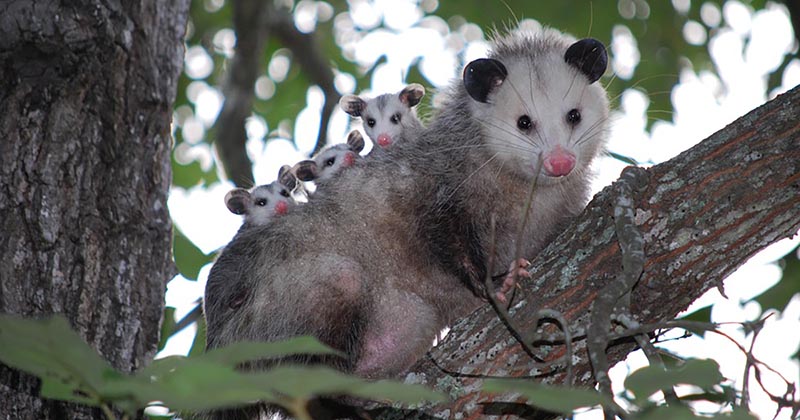Opossums or possums, as they’re more commonly known in Texas, are North America’s only marsupial (pouched mammal). Known as the Virginia opossum, these kangaroo cousins are found throughout most of Texas. With their scruffy gray fur, pointy nose, small ears, and long, naked tail, possums can skew cat-sized rat in the looks department, but, thankfully for the possum, beauty is in the high of the beholder.
Possums provide pest control
Possums get a bad rap (understandable when one has wiped out a chicken coop) but the good rap about them is that that a single possum can eat as many as 5,000 ticks in a week. From the National Wildlife Federation’s “Opossums: Unsung Heroes in the Fight Against Ticks and Lyme Disease”:
“Opossums are extraordinarily good groomers it turns out… they kill the vast majority – more than 95% percent of the ticks that try to feed on them. So these opossums are walking around the forest floor, hoovering up ticks right and left, killing over 90% of these things, and so they are really protecting our health.”
A “robust immune system” protects them from Lyme disease. Possums also have a markedly lower body temperature that many mammals which makes it difficult for diseases, including rabies, to survive. Possums also eat cockroaches, rats, mice, snails, slugs, and carrion. Further, as they are resistant to snake venom, they also prey on snakes including rattlesnakes and copperheads.
Possums really do play dead
A friend of Landmark Wildlife recounts her first possum interaction one cold night. When she let her dogs out, they made a beeline to a corner of her fenced in yard. She grabbed a flashlight, followed the noise, and soon found a dead possum. As it was chilly and late and her dogs’ interest in the critter continued unabated, she snatched a nearby bucket and upended it over the poor critter’s lifeless body. She’d deal with it in the morning. The next day she found a hole dug out from under the bucket and no possum. As it turns out, she said, possums really do play dead.
While many of us have intentionally “played possum,” feigning sleep when our parents tried to wake us for a task we had no interest participating in, a possum playing dead is an involuntary response. They essentially freeze from fear and can remain in this state beyond their control for up to four hours. A curious predator can poke and push, but the possum will not break character. AZ Animals has an interesting summary on this response in “Why Do Opossums Play Dead?” Here are some of the highlights:
- Playing dead is effective because “most predators don’t want to eat an animal that’s already dead…they usually move on if they see an opossum’s lifeless body on the ground.”
- Possums don’t just fall over on the ground, they really sell being dead: “its feet curl up in tiny balls and its body goes rigid…it opens its mouth like it has just taken its last breath (and) may even start to drool…its eyes turn glassy like a creature without a sign of life.”
- Possums also smell dead as they “release a liquid from glands located near the tail (which) gives off a rotting odor.”
Possum life
Possums are nocturnal, solitary animals. Females typically have two litters a year. After just 11-12 days gestation the babies are born, “about the size of a honeybee,” and immediately crawl into the mother’s pouch where they nurse. Babies remain in the pouch for about two months. Litters may be up to 20 but are more commonly 8 or 9; fewer than half typically survive.
Last winter, when South Plains Wildlife Rehabilitation Center in Lubbock posted on social media that a possum they were caring for suffered from alopecia, leaving her hairless, and that she would “need a winter wardrobe,” hundreds of volunteers jumped into action to knit her tiny sweaters. For most possums, however, winter means snuggling down in burrows and relying on fat reserves versus custom, hand-knitted sweaters.
Despite their playing dead trick for survival, the average lifespan of a possum is only one to two years. The short lifespan is generally attributed to predators (including humans). Nevertheless, even in the safety of captivity, possums are not long for this world, living only about four years.
Possum trivia
With the Christmas holidays and social gatherings just ahead, what better entertainment than some possum trivia? Wow friends and family with these nuggets:
Possums were once believed to become impregnated through the nose. Because male possums have a forked or bifurcated penis (not uncommon in marsupials), America’s early European colonizers believed “that the males bred with females through the female’s nostrils, and that the female then sneezed her young into the pouch.” This is not true.
Possums have 50 teeth. You may have seen a possum bare its teeth, but you probably didn’t take the time to count them. The Virginia opossum has 50 teeth, more than any other North American mammal.
Baby possums are called joeys. Like their kangaroo cohort, these baby marsupials are called joeys. A male possum is a jack, a female is a jill, and group of possums is called a passel.
Possums are “living fossils.” Possums are among the world’s oldest mammals, having walked the other with dinosaurs and changing little in appearance in the ensuing millions of years. Hence, you may see possums referred to as “living fossils” on occasion.
Possums have prehensile tails. Their prehensile tail is adapted for holding on to things like trees and manipulating objects. Monkeys, for example, also have prehensile tails. Although possums can use their tail to hang from tree limbs for a period of time, they are not strong enough to sleep that way.
Possums have opposable thumbs. Possums are the only non-primate mammal to possess opposable thumbs. Don’t let a possum borrow your iPhone.










One Comment